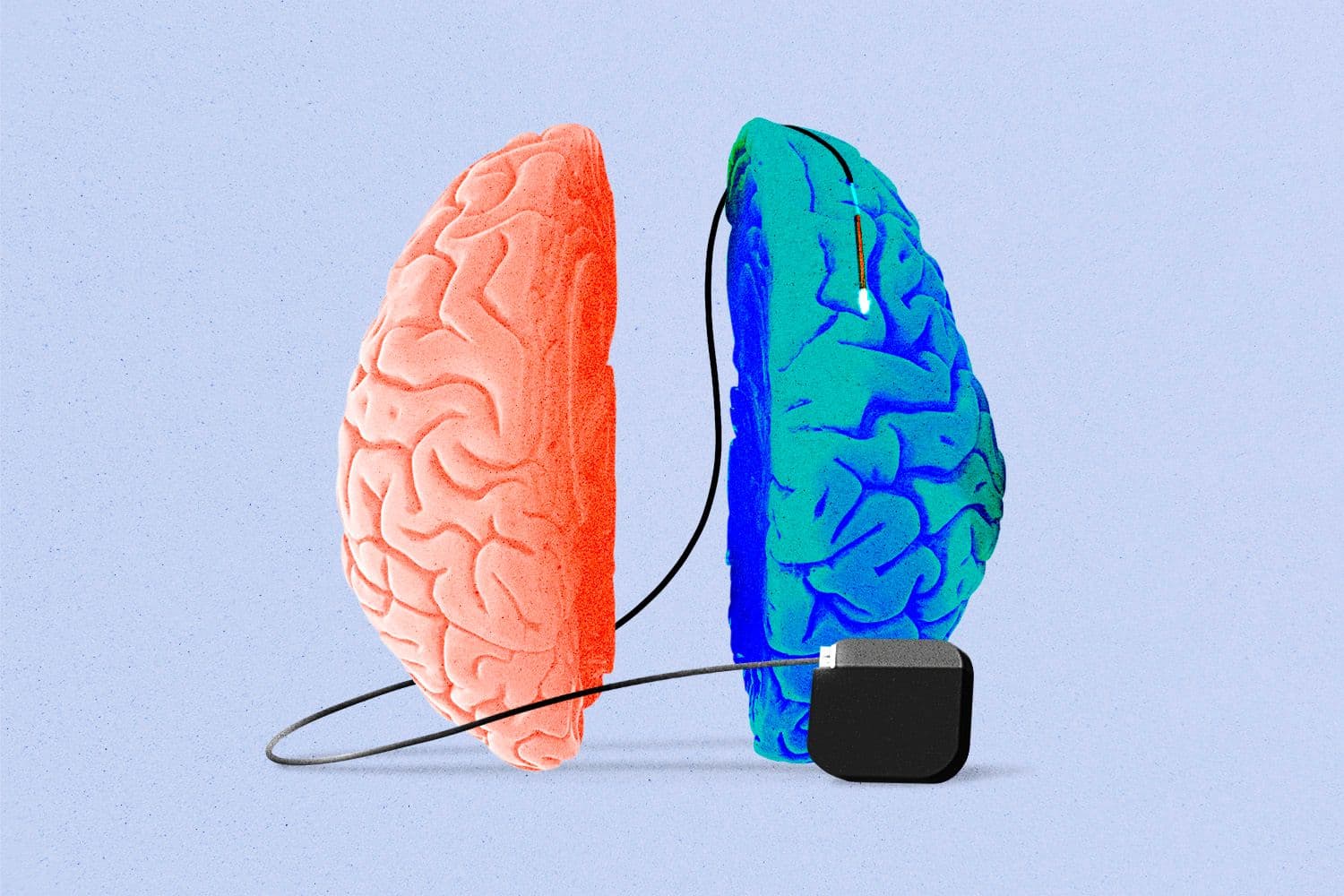Are we entering a neurotechnology renaissance in healthcare?
For Alzheimer’s, chronic pain, and depression, brain stimulation may help where drugs fail.

Illustration: Anna Kim, Photos: Getty Images
• 5 min read
A seemingly old-school tech for treating neurological disorders is gearing up for a comeback. A class of neurotechnology known as neuromodulation is showing promising clinical results for patients with certain illnesses.
Neuromodulation technology uses nervous system and brain stimulation devices to treat a range of ailments including depression and Alzheimer’s. A 2021 survey in the journal Brain Stimulation found 1,252 clinical trials using a neuromodulation treatment, and said the number of registered trials has “trended upward” since 1997, which is when the database first went live.
In 2018, the global neuromodulation market was valued at $4.51 billion. It’s projected to grow to $16.25 billion by 2032.
Last month, a Massachusetts-based biotech, Sinaptica Therapeutics, announced that its transcranial magnetic stimulation treatment improved symptoms of Alzheimer’s and overall well-being, according to recently released data. Also in October, Flow Neuroscience in Sweden showed in its research that at-home transcranial direct current stimulation improved depression symptoms in adults.
Around the same time, medical devices and healthcare giant Abbott announced that it’s rebooting a clinical trial evaluating the effects of deep brain stimulation on patients with treatment-resistant depression. On top of that, several other ongoing trials are evaluating neuromodulation for a variety of psychiatric disorders like obsessive compulsive disorder and schizophrenia.
“The reason neurotechnology has come into vogue again is because we’ve come up against limitations of pharmaceutical therapies,” Ankur Butala, a neurologist at Johns Hopkins Medicine, told Healthcare Brew.
It is difficult for drugs to cross the blood brain barrier, according to 2021 research published in the journal Biomedicines, so they don’t always hit their intended target. They can also bind to receptors elsewhere in the body, leading to side effects like opioid use disorder. In clinical trials for Alzheimer’s, 2% have been successful since 2003.
Brain stimulation is having a moment
As CT scans and MRIs have become increasingly more advanced over the past half century, and electroencephalograms (EEGs) have helped scientists better understand electrical activities across different brain regions, brain stimulation treatments came back into consideration.
Even a decade ago, “the idea that a neuromodulation therapy could displace a drug was really kind of novel,” Ken Mariash, CEO of Sinaptica, said.
Around 2010, Mariash, then at medical device maker Boston Scientific, saw neuromodulation shift from “a boutique industry” into the mainstream following positive results from major clinical studies using brain stimulation technology to treat patients with movement disorders like Parkinson’s, epilepsy, and chronic pain.
Navigate the healthcare industry
Healthcare Brew covers pharmaceutical developments, health startups, the latest tech, and how it impacts hospitals and providers to keep administrators and providers informed.
In Sinaptica’s 2022 positive early trials, clinicians targeted the default mode network in the brain, which plays a big role in memory and cognition. They chose to hone in on this area because previous studies indicated that in Alzheimer’s patients, regular brain activity is altered in this region.
Experts like Butala note that the “novelty” of Sinaptica’s Alzheimer’s technology is the personalization aspect—it maps the unique brain activity patterns for each patient with an EEG, and uses that to guide providers on where to deliver the stimulation and how strong of a frequency to apply.
For chronic pain patients, brain regions like the cortex and prefrontal cortex are highly active, and researchers have been trying to find the best targets there to implement neuromodulation. Todd Vanderah, professor of pharmacology and director of the University of Arizona Health Sciences Comprehensive Center for Pain and Addiction, has partnered with brain-computer interface company ni2o to study the effects of prefrontal cortex-directed transcranial direct current stimulation on pain.
“We’re learning more about the places in the cortex that actually promote that chronic pain,” Vanderah told Healthcare Brew.
Changing tides
Although several brain stimulation devices have been approved by the FDA for the treatment of pain and depression, Vanderah said that they’re not often intended as a first-line treatment, but rather as an option when medications fail.
But there’s a shifting attitude overall in healthcare toward these types of technologies. Healthcare plans are increasingly amenable to reimbursing these therapies, including United Healthcare announcing in 2022 that it would expand coverage of two different types of brain stimulation devices for treatment of pain.
Physicians and neuroscientists are also revising how they view mental dysfunctions in light of the changing science. For example, Mariash said Sinaptica’s approach hinges on the idea that the long-believed villain of Alzheimer’s, amyloid protein clumps, may not be the main cause of the disease.
But Butala cautioned that the science is still early and trials have been too small to see if there’s a significant positive effect on a wide variety of patients—and if the effect sticks.
“We’re maybe not there yet,” he said. “Certainly we’re getting closer, and the studies are promising.”
Navigate the healthcare industry
Healthcare Brew covers pharmaceutical developments, health startups, the latest tech, and how it impacts hospitals and providers to keep administrators and providers informed.